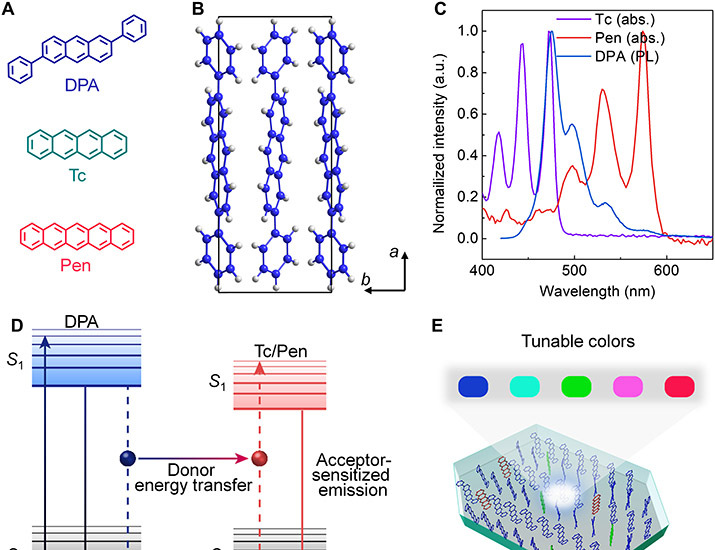Zhengsheng Qin:
ORCID: https://orcid.org/0000-0002-4135-0539
Role: ConceptualizationRole: Data curationRole: Formal analysisRole: InvestigationRole:
MethodologyRole: Project administrationRole: ResourcesRole: SoftwareRole: ValidationRole:
VisualizationRole: Writing - original draftRole: Writing - review & editing
Can Gao:
ORCID: https://orcid.org/0000-0002-2274-0398
Role: ConceptualizationRole: Formal analysisRole: InvestigationRole: MethodologyRole:
Project administrationRole: VisualizationRole: Writing - review & editing
Haikuo Gao: Role: SoftwareRole: Visualization
Tianyu Wang: Role: Visualization
Huanli Dong:
ORCID: https://orcid.org/0000-0002-5698-5369
Role: ConceptualizationRole: Data curationRole: Formal analysisRole: Funding acquisitionRole:
MethodologyRole: Project administrationRole: ResourcesRole: SoftwareRole: SupervisionRole:
ValidationRole: VisualizationRole: Writing - original draftRole: Writing - review
& editing
Wenping Hu:
ORCID: https://orcid.org/0000-0001-5686-2740
Role: ConceptualizationRole: Funding acquisitionRole: Methodology
Journal ID (nlm-ta): Sci Adv
Journal ID (iso-abbrev): Sci Adv
Journal ID (publisher-id): sciadv
Journal ID (hwp): advances
Title:
Science Advances
Publisher:
American Association for the Advancement of Science
ISSN
(Electronic):
2375-2548
Publication date Collection:
July
2022
Publication date
(Electronic, pub):
08
July
2022
Volume: 8
Issue: 27
Electronic Location Identifier: eabp8775
Affiliations
[1
]Beijing National Laboratory for Molecular Sciences, Key Laboratory of Organic Solids,
Institute of Chemistry, Chinese Academy of Sciences, Beijing 100190, China.
[2
]School of Chemical Sciences, University of Chinese Academy of Sciences, Beijing 100049,
China.
[3
]Tianjin Key Laboratory of Molecular Optoelectronic Sciences, Department of Chemistry,
School of Science, Tianjin University, Tianjin 300072, China.
[4
]Haihe Laboratory of Sustainable Chemical Transformations, Tianjin 300192, China.
Author notes
Author information
Article
Publisher ID:
abp8775
DOI: 10.1126/sciadv.abp8775
PMC ID: 9269892
PubMed ID: 35857474
SO-VID: 51bd7c4c-14b8-411b-ad6b-8a292d5c1d8c
Copyright © Copyright © 2022 The Authors, some rights reserved; exclusive licensee American Association
for the Advancement of Science. No claim to original U.S. Government Works. Distributed
under a Creative Commons Attribution NonCommercial License 4.0 (CC BY-NC).
License:
This is an open-access article distributed under the terms of the
Creative Commons Attribution-NonCommercial license, which permits use, distribution, and reproduction in any medium, so long as the
resultant use is
not for commercial advantage and provided the original work is properly cited.
Funded by:
FundRef http://dx.doi.org/10.13039/501100001809, National Natural Science Foundation of China;
Award ID: 51725304
Funded by:
FundRef http://dx.doi.org/10.13039/501100001809, National Natural Science Foundation of China;
Award ID: 61890943
Funded by:
FundRef http://dx.doi.org/10.13039/501100001809, National Natural Science Foundation of China;
Award ID: 22021002
Funded by:
FundRef http://dx.doi.org/10.13039/501100008804, Ministry of Science and Technology, Government of the People’s Republic of Bangladesh;
Award ID: 2017YFA0204503
Funded by:
FundRef http://dx.doi.org/10.13039/501100008804, Ministry of Science and Technology, Government of the People’s Republic of Bangladesh;
Award ID: 2018YFA0703200
Funded by:
Key Research Program of the Chinese Academy of Sciences;
Award ID: XDPB13
Funded by:
Youth Innovation Promotion Association of the Chinese Academy of Sciences, the National
Program for Support of Top-notch Young Professionals, Beijing National Laboratory
for Molecular Sciences;
Award ID: BNLMS-CXXM-202012
Subject:
Research Article
Subject:
Physical and Materials Sciences
Subject:
SciAdv r-articles
Subject:
Chemical Physics
Subject:
Chemistry
Subject:
Chemical Physics

